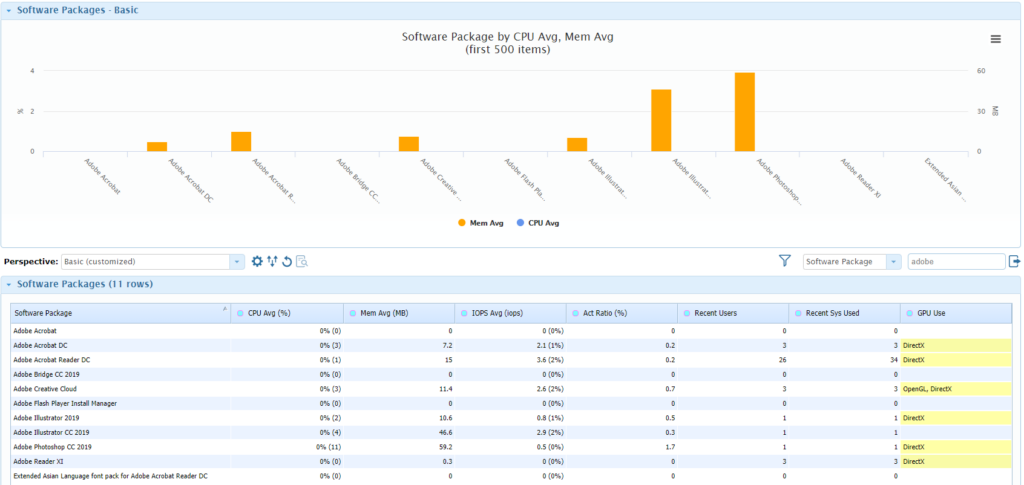
In 2018, Adobe announced a series of changes to their licensing to which many of us have already started adapting. But what are the Adobe licensing changes, which dates should you be looking out for and what do you need to do about them? If you are an IT administrator or a license manager for Adobe software licensing, this post is for you…
What are the Adobe licensing changes?
Spoiler alert: These changes are most likely relevant to you if you have Device-Based Licensing in your environment and/or if you are using one of the discontinued apps. If this sounds like your environment, then these Adobe licensing changes may affect you:
In October 2018, Adobe announced they were going to eliminate Device-Based Licensing to focus on Shared-Device Licensing starting 2019 (if you’re interested in learning about the different types of licenses, skip to this section). This new Shared-Device License is conceptually similar to its Device-Based predecessor but what it does is it brings more personalization to the user experience and more simplification for you which is all around a great thing, although it will take some work on your end to make the switch happen. With this change, Adobe has made it so that if you are looking to move to CC 2019 from CC 2018 and you have Device-Based Licenses in your environment, you will have to switch those over to Shared-Device Licenses in order to use CC 2019.
While you as an admin may not have a choice as to whether or not to move to Shared-Device Licensing, you may be wondering why the extra effort and change. Adobe says they are implementing these licensing changes because their legacy licensing technology is based on a 32-bit application which users and organizations have deprecated in their environments. With the move over to 64-bit, Adobe claims they are providing a much more robust and secure licensing platform. The move also provides a better user experience for labs, libraries, and classrooms because users now will have access to more tools for collaborating, for a more personalized experience (given users will have to sign in to use Adobe Shared-Device Licenses so Adobe will be able to identify each user and customize the experience accordingly), and for accessing creative cloud on the go.
In a recent helpful post by Adobe, they outline some of the benefits of Shared-Device Licensing as compared to Device-Based Licensing. Here is the TL;DR:
| Benefits of Shared-Device Licensing | |
| For users | Access to Adobe XD & Adobe Premiere Rush
|
| Ability to provide users with CC 2019 & the latest versions of apps
|
|
| Access to Portfolio and Adobe Font
|
|
| Better, more customized user experience
|
|
| Use of Adobe Sensei which allows users to access shared libraries and more
|
|
| Access to cloud storage which helps users share content and save without having to connect to an external hard drive | |
| For you | Device management is made simpler: you can group users, control user access to apps, see all associated machines, and other details
|
| Ability to assign admin roles to users so they can perform their own functions instead of contacting IT
|
|
| Application packaging is greatly simplified, you can create packages directly from your Admin console and download them from the console
|
|
But as an administrator, what do these changes mean for you?
- You should not upgrade Device-Based Licenses to Adobe Creative Cloud 2019
- Follow Adobe’s suggested guidance on how to upgrade any discontinued apps
- If you have Device-Based Licenses, start making plans to migrate to Shared-Device Licensing by December 31st. Keep reading for resources on how to make the migration.
When do these licensing changes take effect and what are other important dates?
ScholarBuys breaks down the Adobe licensing changes for us in this very informational video:
In short…
September 1st: Device-Based licenses will be discontinued
December 31st: Suggested migration of all Device-Based Licenses to Shared-Device Licenses
** Your Value Incentive Plan (VIP) anniversary date is your deadline and actual end of life date**
How do you migrate from Device-Based Licensing to Shared Device Licensing?
Step 1: Every successful migration starts with a proper assessment of the current environment. Before you start adapting to the latest Adobe licensing changes, be sure to know the answers to:
– Which machines do I need to deploy Creative Cloud apps?
– Should I increase or decrease the number of machines with Creative Cloud?
– How many users do I have in my environment needing access?
To answer these questions, you can use a digital experience monitoring tool that can ensure a proper and right-sized migration. Below are some screenshots showing the type of data a monitoring tool can provide.

SysTrack showing a summary of average CPU, Memory, IOPS, GPU use and more per Adobe software package

SysTrack showing the inventory of Adobe software packages installed vs used

SysTrack showing named user vs per-device licensing usage
Screenshots shown above are from SysTrack, a digital experience monitoring solution that helps take inventory of the resources and services currently in your environment, the usage and performance of those, and the details on what user experience is really like so you can look into potentially increasing GPU, retire older devices based on data, or make other optimizations. The software solution is often used in anticipation of upcoming licensing changes like those outlined by Oracle for Java in 2018, Office 365 license right-sizing, and more.
- Sign in to the Admin Console
- Click “migrate” on for those device licenses that are set to expire (they will be easily marked)
- Follow the wizard: Define your organization type/types of licenses in your environment
- Confirm and migrate
- Redeploy packages
Note that this is not reversible and that device licenses after migration will stop working in 30 days.
Here are some helpful resources:
Migrate from Device Licensing to Shared Device Licensing
Shared Device Licensing | Deployment Guide: Begin your Deployment
What are the different types of Adobe licenses?
If you need a quick refresher on Adobe licenses, here is a quick overview:
| License type | Key use case | Benefits | Considerations |
| Named User Licenses | – Users whose roles are closely related to a specific Adobe offering and can’t share access
– Most organizations not in education – Individuals – Organizations interested in creating pre-licensed packages that are deployed remotely |
– Easy compliance tracking
– IT admins can add/remove licenses anytime – Single sign-on – Easy management of users – In-transit and at-rest encryption |
– Designed for the network-connected scenario so it requires periodic Internet connection |
| Shared Device Licensing | – Computer labs
– Classrooms – Users that share devices and software |
– More affordable for educational institutions
– Licensing is not tied to an individual user but to a device which could be beneficial for sharing licenses or supporting users that engage with Adobe only part-time – Access to Adobe XD & Adobe Premiere Rush – Ability to provide users with CC 2019 & the latest versions of apps – Access to Portfolio and Adobe Font – Better, more customized user experience – Use of Adobe Sensei which allows users to access shared libraries and more – User access to cloud storage – Simple device management – Ability to assign admin roles to users – Simplified application packaging
|
– Adobe Dimension and Lightroom do not support this licensing model
– BYOD is not supported – This is a part of Adobe’s Value Incentive Plan (VIP) |
| Device-Based Licenses | – Organizations enrolled in the Value Incentive Plan
– Classrooms and labs – Users that share devices and software |
– The user never needs to sign in or enter a serial number to access apps
|
– This is a legacy offering
– App versions of CC 2019 or later do not support device licensing, the latest is CC 2018 |
| Serial number Licenses | – Organizations interested in creating pre-licensed packages that are deployed remotely | – Licensing is not tied to an individual user but to a computer which could be beneficial for sharing licenses or supporting users that engage with Adobe only part-time | – This is a legacy offering
– App versions of CC 2019 or later do not support licensing via serial numbers – Adobe is encouraging the move from serial number licensing to named user |
**Based off Adobe’s Licensing Overview published January 31st
But what do buying programs and license agreements look like for Commercial and Government organizations? For that, Adobe published a series of helpful guides to their buying programs. Below is the overview of their 4 programs and links to the full guides from Adobe.
- Value Incentive Plan (VIP): Subscription licensing but with 1-3 year term-length, support included.
- Products available: Creative Cloud (for teams and enterprise), Acrobat Pro DC (teams and enterprise), Presenter, Technical Communication Suite, Adobe Stock for teams, RoboHelp family, FrameMaker family, Captivate, Presenter Video Express
- Enterprise Term License Agreement (ETLA): 3-year term licensing with offerings designed for large enterprises
- Products available: Creative Cloud (for enterprise), Document Cloud for enterprise, Stock for enterprise, RoboHelp family, Captivate, Presenter, Technical Communication Suite, FrameMaker family
- Cumulative Licensing Program (CLP): Perpetual, volume licensing for purchase of desktop products
- Products available: Acrobat Pro 2019 (desktop only), Acrobat Standard 2019 (desktop only), Technical Communication Suite, Captivate, ColdFusion family, Flash Builder family, Font Folio, FrameMaker family, FreeHand, Photoshop Elements, Photoshop and Premiere Elements bundle, Photoshop Lightroom, Premiere Elements, Presenter Licensed, Presenter Video Express, RoboHelp family
- Transactional Licensing Program (TLP): Perpetual licensing for one-time purchases of desktop products with no contracts
- Products available: Acrobat Pro 2019 (desktop only), Acrobat Standard 2019 (desktop only), Technical Communication Suite, Captivate, ColdFusion family, Flash Builder family, Font Folio, FrameMaker family, FreeHand, Photoshop Elements, Photoshop and Premiere Elements bundle, Photoshop Lightroom, Premiere Elements, Presenter Licensed, Presenter Video Express, RoboHelp family
What’s next?
Start by taking inventory of what you have in your environment so that, once you’re ready to migrate and adjust to the latest Adobe licensing changes, you do so confident in it being an accurate and right-sized environment.
Subscribe to the Lakeside Newsletter
Receive platform tips, release updates, news and more



